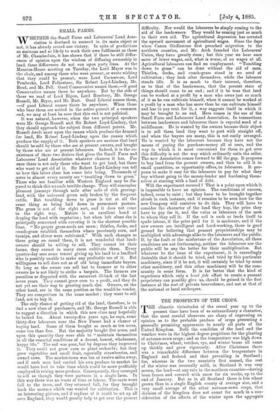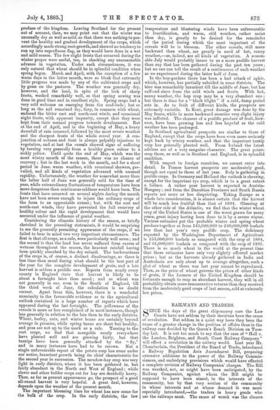THE PROSPECTS OF THE CROPS.
THE climatic vicissitudes of the cereal year up to the present time have been of so extraordinary a character, that the most careful observers are chary of expressing an opinion as to the probable produce of crops presenting a . generally promising appearance in nearly all parts of the United Kingdom. Both the condition of the land and the weather were in the highest degree propitious for the planting of autumn-sown crops; and as the temperature was high down to Christmas, wheat, vetches, rye, and winter beans all came up thickly and grew vigorously. After Christmas there was a remarkable difference between the temperature in England and Ireland and that prevailing in Scotland ; for, whereas in the two countries first named, the rest of the winter was unusually mild, in Scotland it was very severe, the land—at any rate in the northern counties—having been frozen and covered with snow for six weeks, up to the end of January. But as in all Scotland there is less wheat grown than in a single English county of average size, and a very small acreage of the other autumn-sown crops, that division of the kingdom does not count for much in a con- sideration of the effects of the winter upon the aggregate
produce of the kingdom. Leaving Scotland for the present out of account, then, we may point out that the winter was unusually dry as well as mild, so that there was nothing to pre- vent the healthy and gradual development of the crops, which accordingly made strong root-growth, and showed no tendency to run up into superfluous flag, as they would have done in a wet and mild season. The few slight frosts that occurred during the winter proper were useful, too, in checking any unseasonable advance in vegetation. Under such circumstances, it was only natural that wheat should be in splendid condition when spring began. March and April, with the exception of a few warm days in the latter month, were so bleak that extremely little progress was made by any of the cultivated crops and by grass on the pastures. The weather was generally dry, however, and the land, in spite of the lack of sharp frosts, worked remarkably well, so that spring sowing was done in good time and in excellent style. Spring crops had a very cold welcome on emerging from the seed-beds ; but so long as the soil remained dry, they, in common with wheat, endured the bitter east and north-east winds, and occasional night frosts, with apparent impunity, except that they were kept from their normal progress towards development. But at the end of April, and in the beginning of May, a heavy downfall of rain occurred, followed by the most severe weather and the sharpest frosts of the whole cereal year. A con- junction of wetness and frost is always palpably injurious to vegetation, and at last the cereals showed signs of suffering by turning very generally from a healthy green colour to a sickly yellow. Until quite the end of May, which was the most wintry month of the season, there was no chance of recovery ; but in the last week in the month, and for a short period in June, warm weather, with occasional showers, pre- vailed, and all kinds of vegetation advanced with unusual rapidity. Unfortunately, the weather for somewhat more than the latter half of June was generally cold for the time of year, while extraordinary fluctuations of temperature have been more dangerous than continuous coldness would have been. The frosts that have occurred on several nights during the month have not been severe enough to injure the ordinary crops of the farm to an appreciable extent ; but, with the east and north-east winds, they have prevented the full recovery of healthy colour and the rapid development that would have occurred under the influence of genial weather.
Considering the climatic history of the season, as briefly sketched in the preceding statements, it would be surprising to see the generally promising appearance of the crops, if we failed to bear in mind two very important circumstances. The first is that all crops, as a rule, were particularly well sown ; and the second is that the land has never suffered from excess of wetness throughout the season, the heaviest rainfall having been quickly absorbed by the dry subsoil. The backwardness of the crops is, of course, a distinct disadvantage, as there is less time than usual during what should be the best part of the year for the complete development of grain, and a late harvest is seldom a prolific one. Reports from nearly every county in England state that harvest is likely to be about a fortnight later than usual ; and as wheat was not generally in ear, even in the South of England, till the third week of June, the calculation is no doubt correct. Apart from this, however, there is a wonderful unanimity in the favourable evidence as to the agricultural outlook contained in a large number of reports which have appeared during the last fortnight. The yellowness of the cereals is more or less complained of in most instances, though less generally in relation to the late than to the early districts. Wheat, barley, oats, and winter beans are certainly beyond average in promise, while spring beans are short but healthy, and peas are not up to the mark as a rule. Turning to the root crops, we find that mangolds nearly everywhere have planted well and are growing fairly, but that turnips have been generally attacked by the " fly," and in many instances have had to be resown. Not a single unfavourable report of the potato crop has come under our notice, luxuriant growth being its chief characteristic for the second year in succession. The meadow-hay crop was very light in early districts, where it has been gathered in, but fairly abundant in the North and West of England ; while clover and other fodder crops cut for hay are decidedly heavy. Thus, as far as present appearances go, the prospect of a good all-round harvest is very hopeful. A great deal, however, depends upon the weather of the present month. The important blooming time for wheat has now come for the bulk of the crop. In the early districts, the low temperature and blustering winds have been unfavourable to fructification, and warm, still weather, rather moist than dry, is greatly to be desired for the remainder of the period during which the most important of the cereals will be in blossom. The other cereals, still more backward than wheat, are greatly in need of hot, sunny weather,—as, indeed, are all kinds of vegetation. A season- able July would probably insure to us a more prolific harvest than any that has been gathered during the past ten years ; but no one can tell the result of a continuance of such weather as we experienced during the latter half of June.
In the hop-gardens there has been a bad attack of aphis, which, however, has partially subsided in some districts. The bine was remarkably luxuriant till the middle of June, but has suffered since from the cold winds and frosts. With hot, sunny weather, the hop crop may be a very abundant one ; but there is time for a " black blight " if a cold, damp period sets in. As to fruit of different kinds, the prospects are extremely variable. In Kent, great damage was done by the May frosts, while in more backward counties very slight injury was inflicted. The chances of a prolific produce of fruit, how- ever, have been growing less and less hopeful as the cold. weather has been prolonged. In Scotland. agricultural prospects are similar to those of England, except that the crops have been even more seriously kept back by wintry weather, and that the important turnip crop has generally planted well. From Ireland the latest advices are of a very sanguine character. The great potato crop there, as well as in Scotland and England, is in splendid. condition.
With respect to foreign countries, we cannot enter into detail. In France harvest prospects are moderately good, though not equal to those of last year. Italy is gathering in prolific crops. In Germany and Holland the outlook is cheering, except for the important rye crop, which is to a great extent a failure. A rather poor harvest is expected in Austria- Hungary ; and from the Danubian Provinces and South Russia reports are more or less disquieting. Taking Europe as a whole into consideration, it is almost certain that the harvest will be much less fruitful than that of 1884. Glancing at the other side of the Atlantic, we find that the winter wheat. crop of the United States is one of the worst grown for many years, great injury having been done to it by a severe winter. Various estimates put the probable winter and spring wheat produce together at from 145,000,000 to 240,000,000 bushels less than last year's very prolific crop. The deficiency expected by the Washington Department of Agriculture is 153,000,000 bushels as compared with the crop of 1884, and 61,000,000 bushels as compared with the crop of 1883. There is so much wheat in the world at the present time that these estimates have only very slightly affected market prices ; but as the harvests already gathered in India and Australasia are only about up to average altogether, such a glut of wheat as there was last year cannot be reproduced. Then, as the price of wheat governs the prices of other kinds of grain, if the farmers of the United Kingdom should be fortunate enough to reap an abundant harvest, they will in all probability obtain more remunerative returns than they received from the moderately good crops of last season, sold at ruinously low prices.



































 Previous page
Previous page